Why Do Cats Eat Grass?
Share:
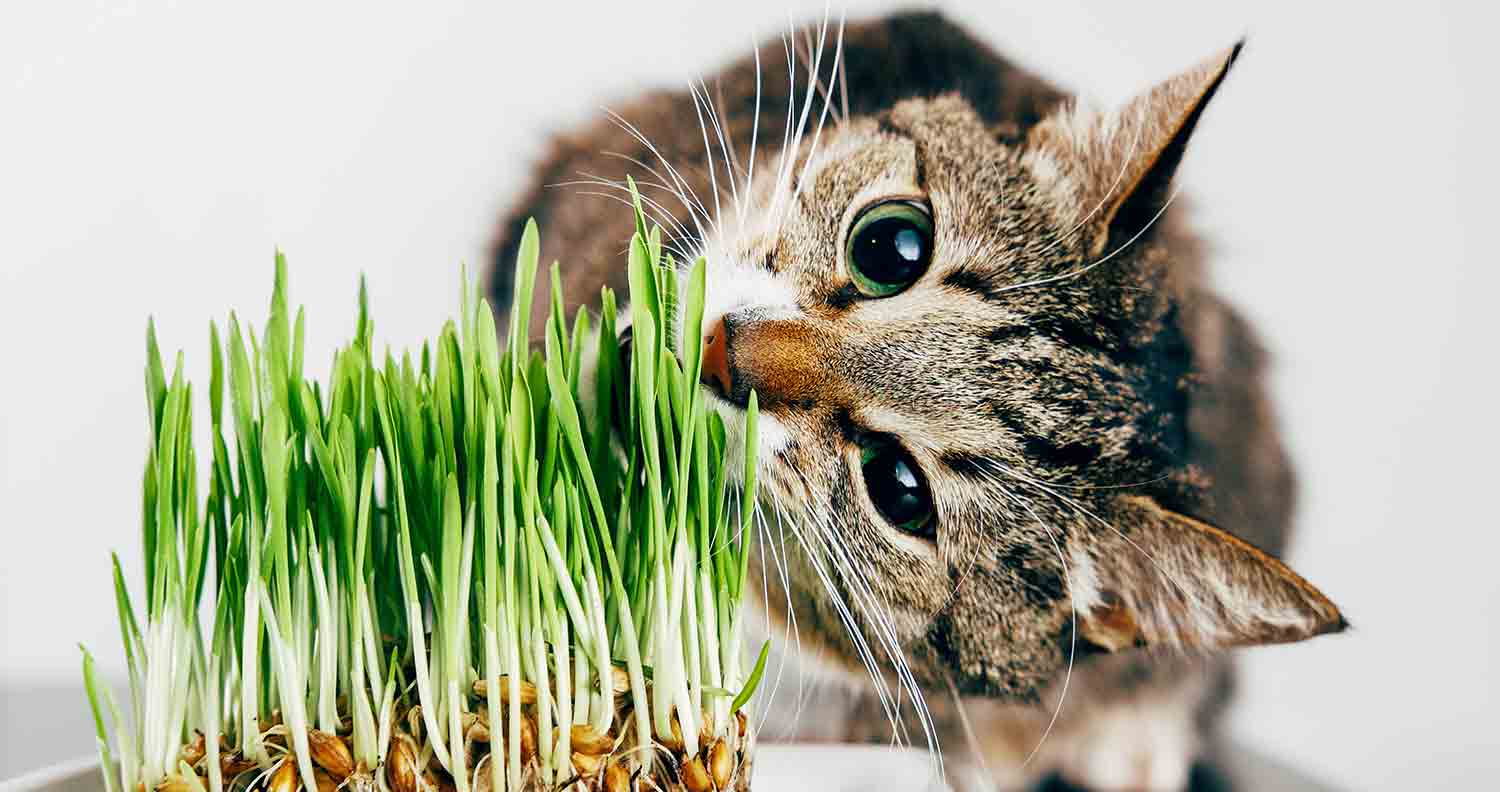
It's a strange one! Cats and dogs are obligate carnivores aka meat-eaters. So why do cats and dogs eat grass?
Wild cats eat whole prey, including the stomach contents. The stomach contents of prey contain predigested plant matter. This predigested plant matter provides nutrients that support healthy gut flora. Since indoor cats do not eat the same diet, they may eat grass to help support their gut.
So why do cats eat grass and vomit?
Just to start off with, if you see your furry friend vomiting and are concerned about their behaviour then you can always refer to our article that discusses in detail, why is my cat vomiting?
However, if vomiting persists we strongly recommended you get kitty to a vet and quickly. But in this case we will be discussing the much more natural vomiting that occurs after our moggies eat grass.
So why? Cats are classified as obligate carnivores. Obligate carnivore means restricted to a meat-only diet. So if they are restricted to a meat-only diet, why would cats eat grass?
Additionally, many cat parents say that their cat will eat grass and then throw up. Why would cats eat grass if it makes them throw up?
We will have to discuss the cat's ancestral diet and how it affects our indoor cats. Our fur babies may be domesticated now. But wild instincts are ingrained in all cats.
Even if they've never been outside.
Cats may eat grass for nutritional value, as grass contains trace nutrients and beneficial bacteria.
They may also eat grass because it stimulates a purge of harmful materials that may have been ingested.
But of course, there are cat-safe grasses as well as very toxic grasses that can be harmful. So let's take a look at the cat's wild counterpart and go from there!
Do big cats eat grass?
Big cats have been seen chomping on grass. Researchers believe that wild cats eat grass to expel parasites and absorb trace nutrients. It's important to remember, however, that the wild cat does not rely solely on grass for nutrition. Cats hunt prey and eat much larger amounts of their main food than grass.
Grass contains trace nutrients such as:
Plants also provide some moisture. However, more research needs to be done about using grass to supply these nutrients.
The main diet of big cats is whole prey. Cats consume the stomach contents as well as the intestines of their prey. Since cats eat herbivores, they will consume some predigested plant matter. This plant matter is essentially a fermented vegetable mix.
The fermented veggie mix provides probiotic beneficial bacteria and volatile fatty acids. Consuming the fermented veggie mix can help promote healthy gut flora in the cat.
Big cats eat grass for the same effect. The cats may ultimately consume some soil while they eat grass. And there can be beneficial bacteria in the soil and roots of the grasses that they eat. Perhaps they see grass as a healthy nutrition-packed snack between meals!
Additionally, wild cats may consume grass and soil left on their paws after using the bathroom. Wild cats dig and bury their business in the grass and dirt. Just like your fur baby digs and buries in the litter box!
Inevitably, wild cats will consume some of that grass and soil when they groom. Wild cats would also get beneficial bacteria from the soil, similar to the stomach contents of prey.
Do indoor cats need to eat grass?
Since wild cats eat grass, you may be wondering if your indoor cat needs to eat grass. Indoor cats may not need to eat grass. But it may be beneficial. On top of trace nutrients, chewing on grass can provide mental stimulation and enrichment. Mental stimulation and enrichment are crucial for indoor cats.
Proper enrichment and stimulation can help prevent boredom, stress, behavior issues, and possibly even health issues! Just imagine how you feel when you're out and about and keeping busy. Cats need similar stimulation and indoor enrichment to keep their brains sharp and their moods high.
Giving our cats a taste of their wild side can help provide enrichment. All cats have natural instincts. And when we nurture those instincts properly, our cats are much happier indoors. Even turtles benefit from environmental enrichment!
Other forms of enrichment include playing with your cat. And maybe even an outdoor adventure, whether that's around town or a serious hike. Just be sure to use a proper cat harness and leash if you plan to let your cat walk around, and check out our advice on choosing the best cat backpack. And watch out for potentially dangerous grasses during your walk.
It's much safer for your cat to eat cat-safe grasses free from chemicals and pesticides. Ideally, your cat would eat grasses that you've grown safely indoors.
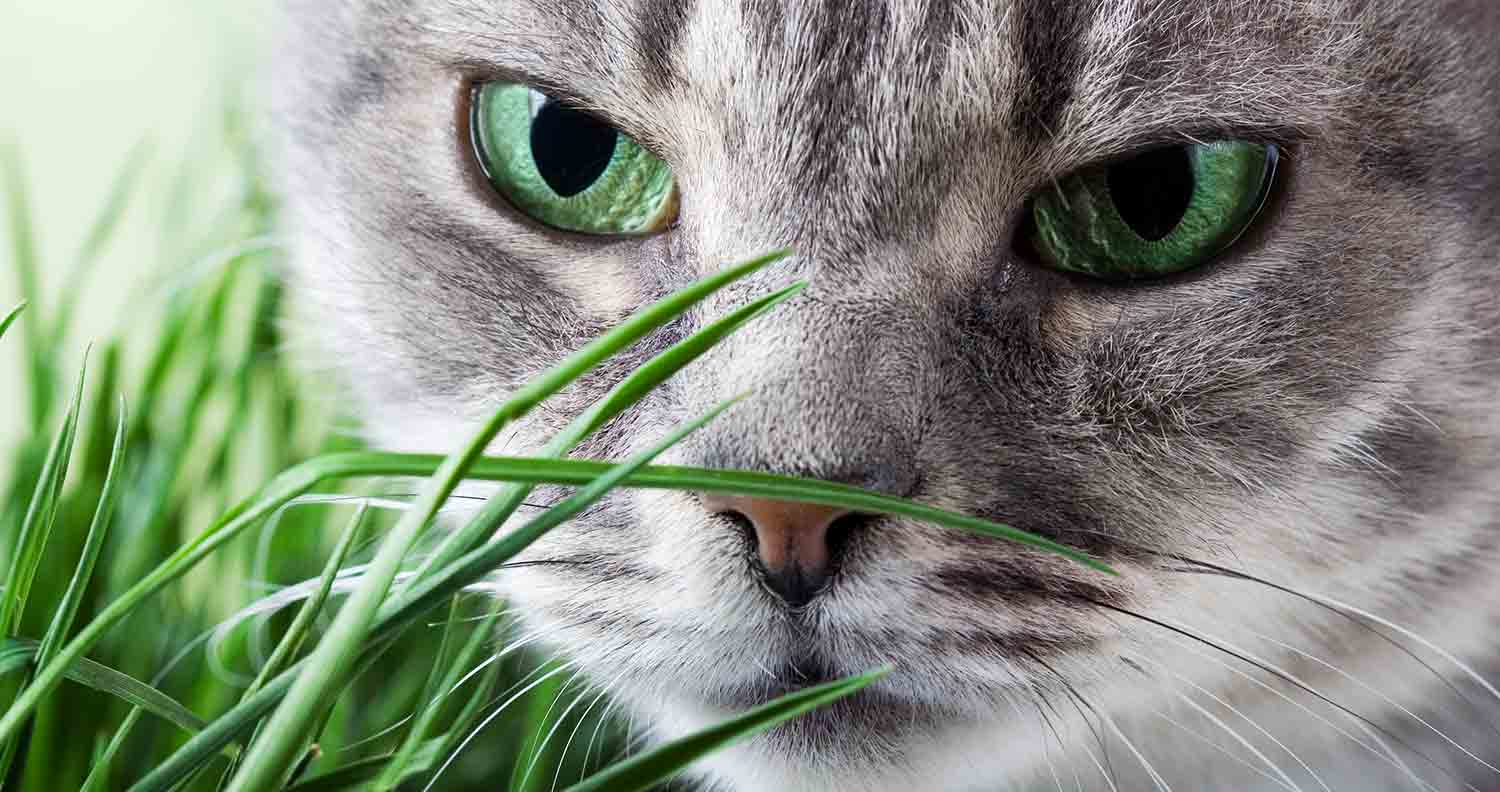
But do domesticated cats even eat grass?
Apparently, domesticated cats DO eat grass! Even more surprisingly, many of those cats did not vomit after eating grass.
Researchers ran a web-based survey among 1,021 cat owners to see how many cats actually eat grass. They found that 71% of cats snacked on grass. And 11% of cats were never observed eating grass. This survey shows that even domesticated cats have the natural instinct to eat grass.
Interestingly, 91% of the cats eating grass did not appear ill or sick prior to eating grass. So cats may eat grass simply for the trace nutrients and beneficial bacteria. Not all cats eat grass because it makes them vomit.
However, it's important to remember that cats are masters at hiding their pain. Cats are both predators and prey in the wild. Any signs of weakness will make the cat an easy target. So cats will avoid showing signs of weakness. Remember, these survival instincts are ingrained in all cats. Even if your cat has never been outside.
So these cats may not have appeared ill, but only the cat knows for sure. Cats are very intelligent beings that have natural ancestral instincts on their side.

Get 30% off and FREE shipping on cat food!
U.S.A. only
To Find out why we recommend chewy.com, click here
The research team concluded that cats eat grass as part of a health regimen. But it's not something that most indoor cats need. Wild carnivores mainly eat grass to purge parasites. Thankfully, our domesticated furballs generally don't need to worry about parasites as much as their wild counterparts.
But this still doesn't answer why domesticated cats eat grass. If indoor cats don't need to expel parasites, why do they eat grass?
What does it mean when cats eat grass?
Cats eat grass for a few reasons. It may be to expel parasites or to absorb trace nutrients. But there are a few other reasons that cats eat grass.
Cats may eat grass because:
Grass can clean the gut
Since cats are obligate carnivores, their digestive system is designed to digest meat. That means plant material is not easy to digest for cats. So your cat may eat grass to help him clear out his digestive system.
Maybe your cat ate something he isn't supposed to. Or maybe he has a hairball that needs to come up. Your cat may eat grass to help his body regurgitate what he cannot digest. Eating grass may also relieve constipation.
Cats eating grass is instinctive
As we discussed, wild cats eat grass. And these instincts are ingrained in all cats. Just think about how your cat grabs a toy and shakes his head quickly to "kill it". Or how your cat digs and buries his waste in the litter box.
All of these instincts are ingrained. Even if your cat has never been outside. Domesticated cats may eat grass simply because their wild ancestors do it too.
Grass provides trace nutrients
Cats that eat dry food only may be deficient and/or dehydrated. Dry cat food is extruded which is cooked and pressurized three times. So the pet food manufacturer has to add back many vitamins and minerals.
Dry kibble also contains very little moisture. The average moisture content of kibble is 10%. But the cat's natural diet provides between 70-80% moisture. So cats may instinctively eat grass to make up for nutrient losses.
Grass is a natural cat toy
There are many cat-safe types of grass out there, including the most famous catnip. Many cats love catnip toys. Catnip makes most cats feel happy, calm, and playful.
You may even notice that your cat bats at and tries to play with your plants. Cats are just naturally attracted to grass. Because, again, these instincts are ingrained in all cats.
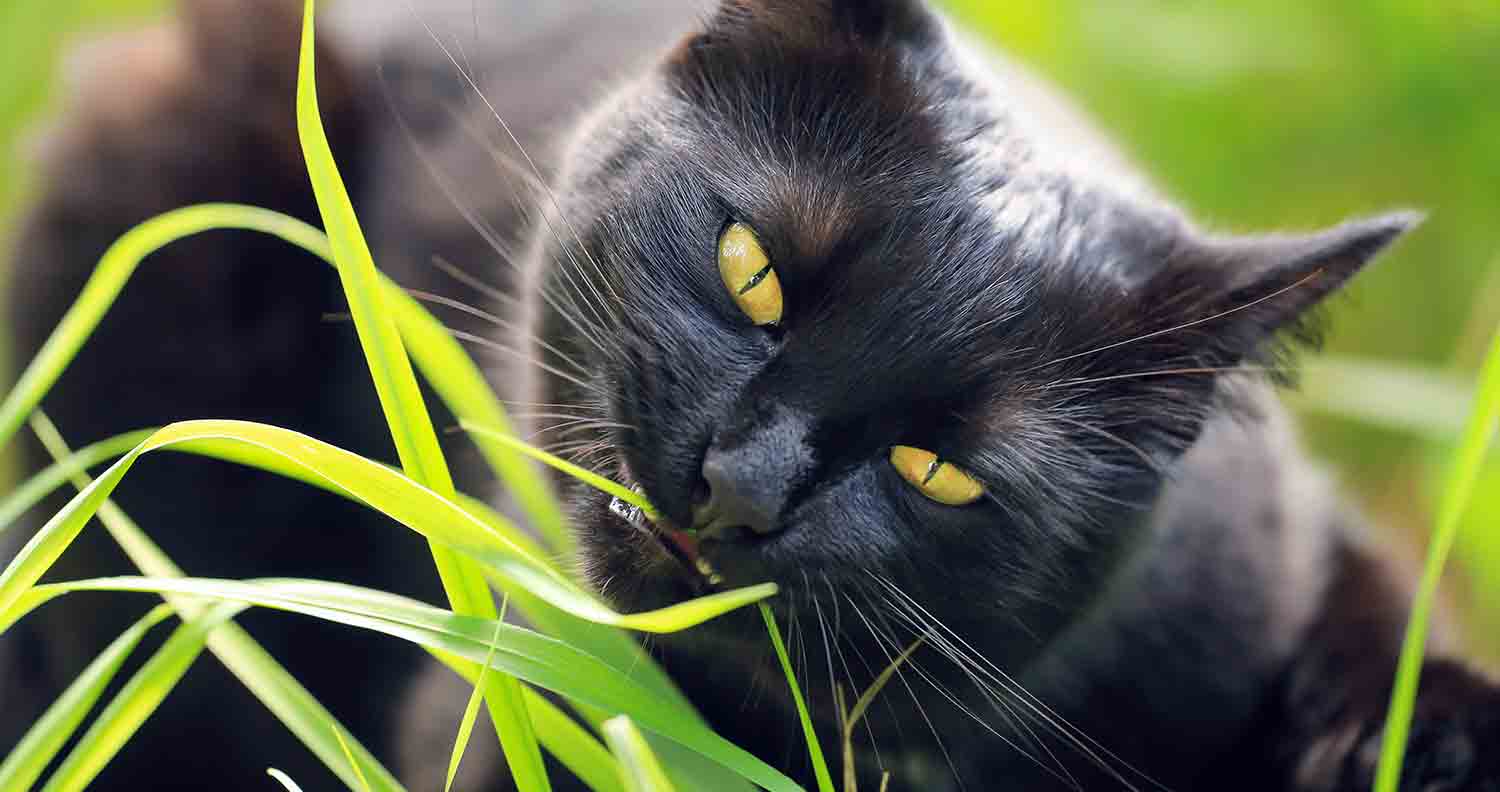
Why do cats eat grass and then throw up?
Cats may eat grass and then throw up because the grass is indigestible. Obligate carnivores are designed to digest meat, not plants. So cats typically vomit after eating grass. Some cats eat grass specifically because it makes them vomit.
Wild cats consume grass to help expel parasites and to clear out their digestive system. In this case, it's important for the cat to vomit. The cat consumes the grass specifically to vomit harmful materials.
However, not all cats vomit after eating grass. And not all cats eat grass because it makes them vomit. Some cats munch on grass simply because it's instinctual or they see grass as a toy.
Other cats eat grass for the trace nutrients. Chewing on grass releases these nutrients. So the cat will still absorb these nutrients. Even if he vomits right after eating it.
Every cat is an individual. But these are the basic instincts and reasons that cats eat grass and may vomit afterward.
Is eating grass bad for cats?
Eating some grass may be bad for cats. For example, grass and/or soil is bad for cats if it is contaminated with fertilizers, roundworms, or other harmful materials.
We have also compiled this list here of foods that are potentially harmful to cats.
Additionally, some plants like lilies and many others are toxic to cats.
Plants that are toxic to cats include:
Plants from the Araceae family
These plants include philodendron, pothos, peace lily, calla lily, dumb cane, arrowhead vine, mother-in-law’s tongue, sweetheart vine, devil’s ivy, umbrella plant and elephant ear.
These plants are toxic because they contain insoluble calcium oxalate crystals that can cause serious mouth pain.
The Araceae family plants may not be not deadly, however, you should still seek a veterinarian's help if your cat nibbles on one of these plants.
English shamrock, rhubarb (leaves) and tropical star fruit
These plants contain soluble calcium oxalates. Poisoning is rare, however, it is life-threatening.
Ingesting these plants causes blood calcium levels to plummet and can also cause crystals to form in the kidneys.
Kalanchoe plants
Kalanchoe plants are poisonous because they contain cardiac glycosides.
Corn plant/dragon tree
Corn plants contain saponins that interfere with the absorption of essential nutrients.
Spring flowers
Spring flowers like tulips and daffodils can cause vomiting and diarrhea if the bulbs are ingested. Additionally, the bulbs can cause an obstruction in the intestines and stomach.
Signs that your cat is ill from eating plants include GI problems like vomiting and diarrhea plus lethargy, loss of appetite, drooling, elevated heart rate and respiration, and dilated pupils.
If you suspect your cat has consumed a dangerous plant, contact your veterinarian or emergency clinic immediately. You may also phone the ASPCA Animal Poison Control Center at 888-426-4435, or the Pet Poison Helpline at 855-764-7661.
If your cat is eating cat-safe grass, however, it may not be bad for your cat.
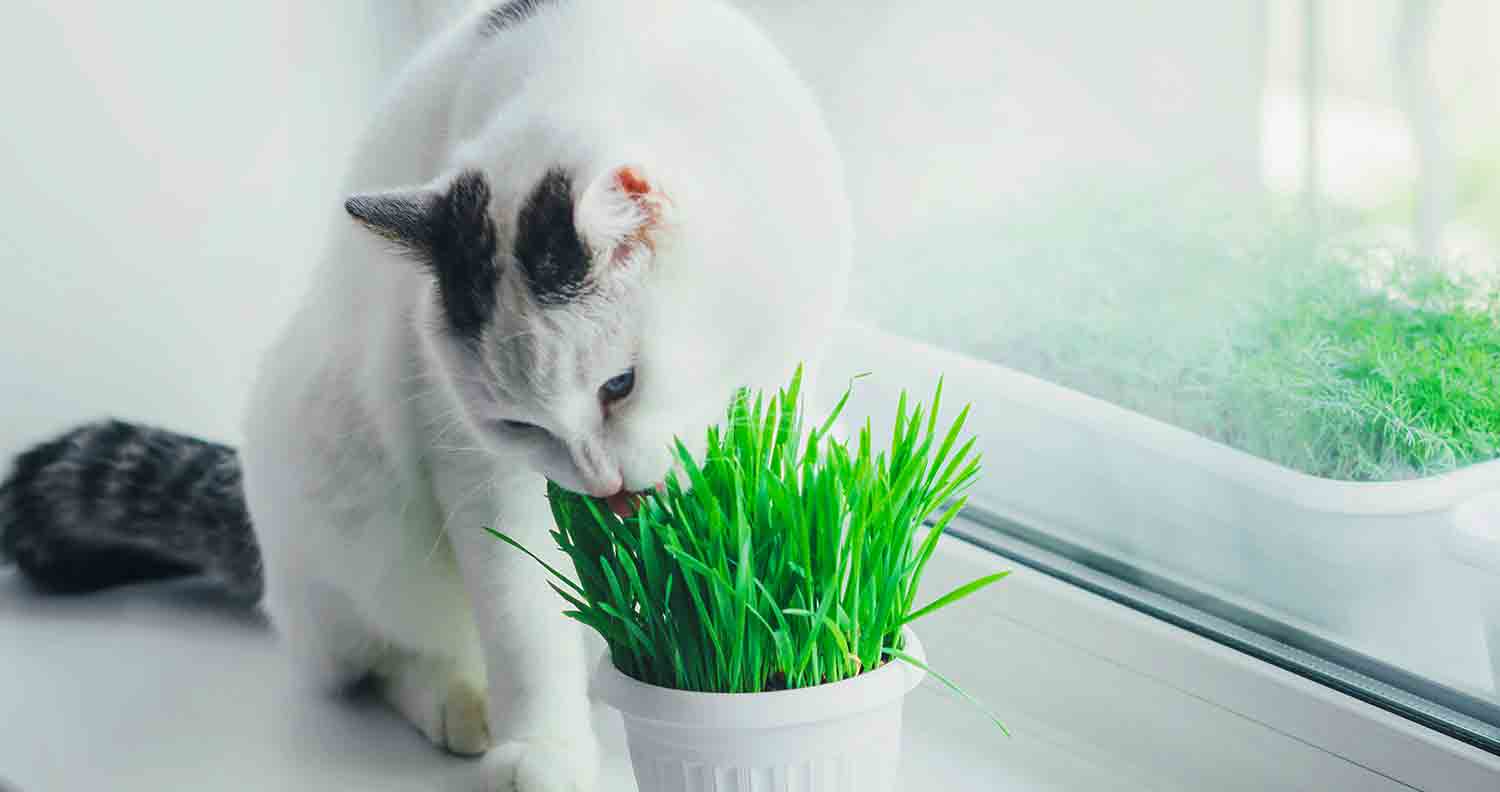
What is the best grass for indoor cats?
The best grass for indoor cats is one that is cat-safe and nontoxic. You can easily grow a cat garden indoors or in your cat's outdoor catio enclosure. A cat garden can keep your cat entertained, provide some trace nutrients, and give him a safe household item to chew on.
Best grass and plants for indoor cats:
Catnip
Catnip toys are very popular for a good reason. The catnip plant is part of the catmint family and contains a chemical terpene called nepetalactone.
This terpene tickles the cat's opioid receptors in the brain. And it promotes a happy, calm, and playful mood. Some cats rub and roll around on catnip. Others may drool and appear very relaxed.
Silvervine
If your cat doesn't fancy catnip, Silvervine is an excellent alternative.
In a study among 100 domestic cats, 79% of them responded to Silvervine. And 68% responded to catnip. Silvervine smells a bit minty, just like catnip.
Tatarian Honeysuckle
Tatarian Honeysuckle is another catnip alternative. In that same study, 53% of cats responded to Tatarian Honeysuckle. This is another great alternative to catnip.
All of these plants contain compounds that stimulate olfactory enrichment. This enrichment can be very beneficial, especially for indoor cats. Enrichment and mental stimulation keep cats busy and can prevent boredom and stress.
Valerian
Valerian is yet another catnip alternative. But only about half the cats in the study responded to it. I've tested catnip keef, Silvervine, and Valerian root powder with my cat. He treasures Silvervine the most.
And I've found that Valerian root smells a bit like feet. Many cats do love sniffing inside shoes, though!
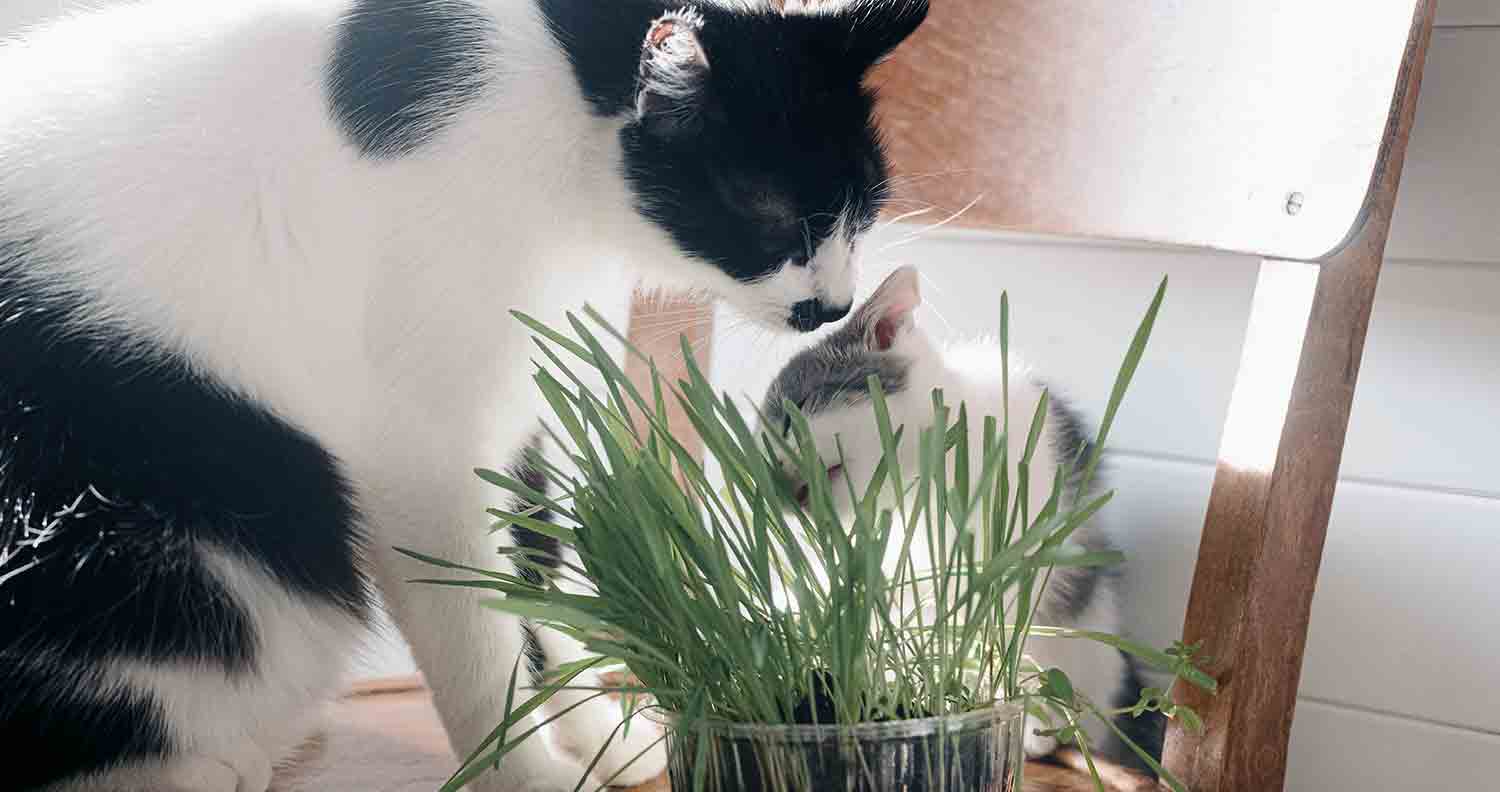
Cat grass
Cat grass is easy to grow indoors. You can buy a cat grass kit online and you will probably find a growing kit at your local pet store. Typically, cat grass is grown from oat, barley, rye, or wheat seeds.
This is a much safer option for your cat considering outdoor grass may be chemically treated.
Lemongrass
Lemongrass may cause a similar effect to catnip. Lemongrass is safe for cats to chew on and eat.
However, if you notice that your cat really craves the stuff, there may be an underlying medical issue. Seek advice from your veterinarian if your cat craves lemongrass.
Spider plant
Spider plants are very popular and make beautiful indoor house plants. This house plant is completely safe for cats.
And it makes a great alternative to many other popular house plants.
There are many more cat-safe plants out there. But cats typically respond to these the most.
You can use catnip and its alternatives to get your cat in a playful mood with new toys. Or you can use it to help calm him down before a stressful situation, like going to the vet.
DIY catnip toys are very easy to make with some catnip and alternative powders. Or you can buy already made catnip toys.
If your cat enjoys eating grass, and there are no GI problems, plant a pot of one of these for fun enrichment.
Final thoughts on Why do cats eat grass?
Cats eat grass for many reasons. It could be simply because it's instinctual. Wild cats typically eat grass to purge parasites and clean out their gut. These natural instincts are ingrained in our domesticated cats. Even if they've never been outside.
Other reasons that cats eat grass include enrichment and nutrition. Grass contains trace minerals and healthy bacteria from the soil.
It's important to note that if your cat has an insatiable craving for certain grasses, there may be an underlying medical issue. If you notice the same with your cat, or if there are very frequent GI problems after consuming grass, seek advice from your veterinarian.
Additionally, make sure the grasses available to your cat are safe and nontoxic. Many outdoor grasses are treated with chemicals and pesticides.
So the safer option is to grow an indoor cat garden from cat grass, catnip, or another cat-safe plant.

Get 30% off and FREE shipping on cat supplies!
U.S.A only
To Find out why we recommend chewy.com, click here
Affiliate disclosure : We Love Cats and Kittens is a participant in several affiliate programs including the Amazon Services LLC Associates Program, and the Chewy affiliate program. These are affiliate advertising programs designed to provide a means for sites to earn advertising fees by advertising and linking to products on their sites. If you click on links in our blog posts and articles we may be paid a commission.
Share:

